#troglofauna
Explore tagged Tumblr posts
Text
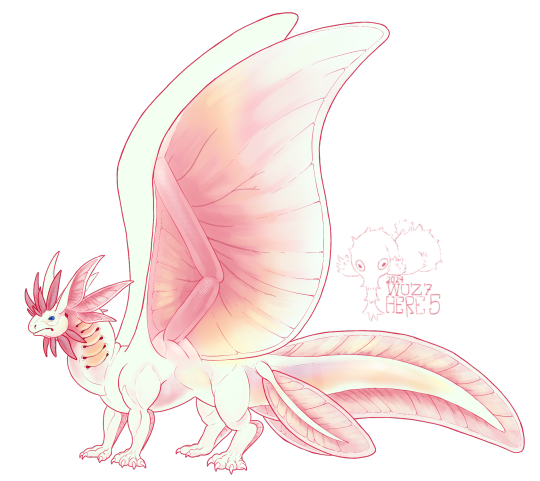
Did a hand-drawn reference for my ROS girlie, Axolotl
#my art#procreate#digital art#dragon#2024#Ros#ros tidekeeper#Tidekeeper#oc#axolotl#olm#Troglofauna#Dragon art#dragon oc#realm of serpents
344 notes
·
View notes
Text
Wet Beast Wednesday: cave fish
Prepare for a deep dive today. Not because I'm going to be more in-depth than usual, but because we're talking about caves. Which are deep. In the ground.... Yeah, you get it. Today is going to be a bit different from my normal WBW posts. Instead of going in depth on a particular species or group of related species I'm going to discuss common adaptations fish evolve to live permanently in caves and then go over a few species I find interesting. Let's get spelunking.
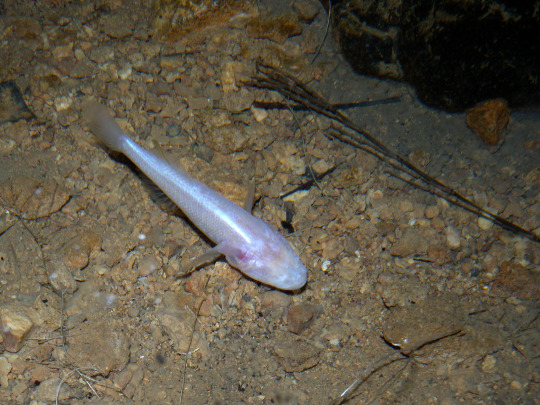
(Image: Typhleotris madagascariensis, a typical cave fish. It is a small fish with an entirely white body and smooth skin where the eyes would be on a normal fish. It is resting on rocky sediment. End ID)
Caves are not an easy place to live. There's no light, limited food, often low oxygen levels, and the threat of collapse or rockfall. Cave-swelling animals (collectively called troglofauna) need a number of special adaptations to survive and there is little room for error. Troglofauna that are strictly aquatic are called stygofauna. Troglofauna and stygofauna can be divided into three groups based on their life history. Troglophiles and stygophiles complete part of their life cycle in caves and part outside of them. A classic example of this is the many species of bat who seasonally inhabit caves to give birth and mate. Trogloxenes and stygoxenes are animals who will visit caves, but do not require time in caves to complete their life cycle. An example trogloxene would be a bear who takes shelter in a cave during winter. Finally, troglobites and stygobites live their entire lives in caves and never leave. The fish I discuss today are stygobites. Because troglobites and stygobites generally will die outside of their caves, they have very little opportunity to disperse. As such, many cave fish species are found only in a single cave or cave system and are entirely dependent on the health of their homes to survive.
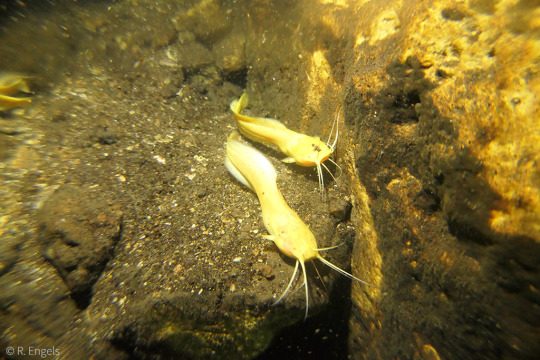
(Image: two cave catfish sitting next to each other on a rock. They are white with elongated anal and rear dorsal fins, and no eyes. End ID)
Many cave-dwelling animals develop a set of common adaptations called troglomorphism. Cave water is often high in minerals but low in oxygen and food content. To survive, the fauna develop very slow metabolisms, allowing them to last a long time on limited resources while slowing down movement and other active systems and increasing age. These species are also typically smaller than their epigean (above-ground) relatives, further reducing their energy requirements. Slowed metabolism results in comparatively slow development. Cave species take much longer to mature and reproduce then related epigean species. Many species further decrease their energy consumption by moving as little as possible. Many species of cave fish are able to last long periods of time between meals without negative impacts to their health. They will binge eat whatever they can find and then subsist on fat stores while food is scarce. One test in captivity showed that a Phreatobius cisternarum (cave catfish) could go a while year between meals and stay healthy. Cave species are usually opportunistic generalists as they can't afford to pass up resources. Much of their food will originate outside of the cave, either directly or indirectly. Water flow into caves brings in algae, bacteria, plankton, and other food sources. Other more indirect methods of introducing include bat feces. While the fish may not eat the feces directly, other species may do so and potentially become prey to the cave fish. The feces also introduces nutrients from outside the cave that encourages the growth of other food sources like bacteria, fungi, and planktonic animals.
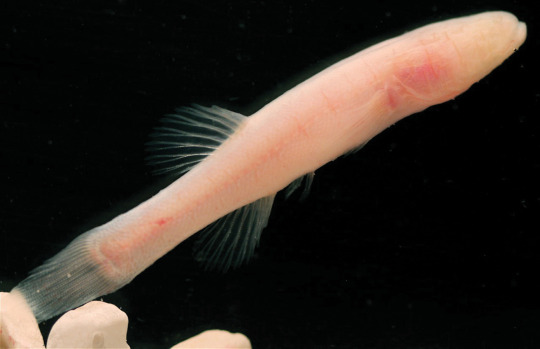
(Image: Amblyopsis hoosieri, the hoosier cave fish. It is a very simplistic fish with no eyes or scales. End ID)
Life in a cave comes with a different sensory requirement. The complete lack of light makes vision useless. You don't know dark until you've seen cave dark. Fun fact: caves are so dark that sighted people can start hallucinating in them because our brains aren't evolved to handle zero visual stimulus and will start making stuff up to fill that gap. As a result of the utter darkness, many species of cave fish are blind. They either evolve to completely lose their eyes or have the eyes considerably reduced in size and function. Eyes take up a lot of energy to maintain and in caves, there is a lot of selective pressure to get rid of organs that aren't useful there. Despite the blindness, many species retain some form of photosensitivity and will flee from light. Cave species also often lack skin pigmentation. Skin pigment has two primary uses. It protects the skin from ultraviolet light in sunlight, and provides skin coloration that can be used for camouflage, displays, warnings, and so on. In an environment where there is no ultraviolet light and everyone is blind, skin pigment serves no real purpose and is lost. As a result, most cave species are white or translucent. The lack of pigment may be a reason so many species remain photosensitive. Without pigment, they would be highly susceptible to sunburn or skin cancer from ultraviolet light. Caves also have a sound dampening effect that makes hearing less valuable. Reduced eyes and pigmentation is also seen in deep sea fish that live too deep for light to reach. Even those species still use visual curs more than cave fish due to the abundance of bioluminescence in the deep ocean.
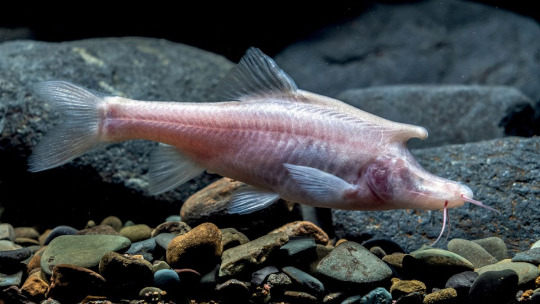
(Image: Sinocyclocheilus longicornus, a recently discovered species. It is a fish with translucent skin, revealing the skeleton. It has a long shout with two pairs of barbels. Emerging from the upper back is a horn-like protrusion. End ID)
With vision off the table, cave fish rely on other senses. chemoreception through taste and smell are strongly selected for as traits that can direct cave animals toward food or away from threats. Another sensory system fish have is the lateral line. The Lateral line is an organ system found on each side of a fish where modified skin cells called hair cells detect motion in the water. The lateral line allows fish to sense movement in the water around them, informing them of water flow and the movement of food and threats. Cave fish typically have a well-developed lateral line system that compensates for the lack of vision. Many fish perform displays for various reasons, such as attracting mates. These displays are typically visual, but in cave fish, that isn't an option. Instead, their displays are more focused on moving the water in ways that can be detected by lateral lines. Some species of cave fish maintain additional sensory abilities from their epigean ancestors. An example of this are cave catfish, who retain the barbels and electroreception common to their kind.
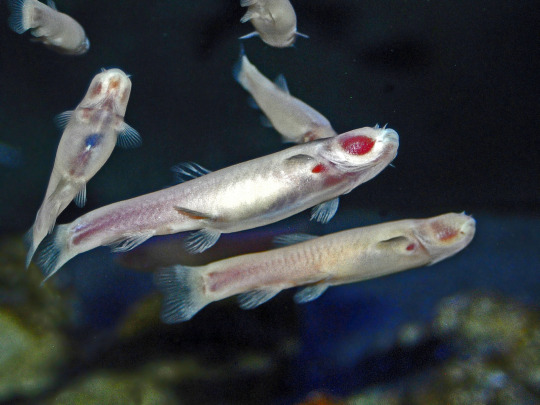
(Image: six Phreatichthys andruzzii. They are long, eyeless, white fish. The blood-filled gills are visible through its translucent skin, seen as a large red patch on the head. End ID)
Before moving on to specific species, it should be noted that cave fish is not a taxonomic category. Cave fish come from many different lines of descent and independently evolved similar adaptations to cave conditions. These similar adaptations are seen in most cave fauna, not just fish, and are collectively called troglomorphism. There are about 300 species of cavefish known to science.
Ophisternon candidum, or the blind cave eel, lives in north Australian caves that are connected to the ocean. Because these caves intake salt water, the pools and streams within them can become very salty, resulting in the eels developing a tolerance to a high range of salinity. They are rare, having been spotted under 40 times since 1959, and thus little is known of their lifestyle. We do know they burrow into sediment and secrete mucus to keep those burrows stable. Males seem to build burrows to woo females. They have been bred in captivity for use un laboratories. At up to 40 cm long, they are huge for cave fish and used to hold the record for the largest species known until another species was found that's even bigger.
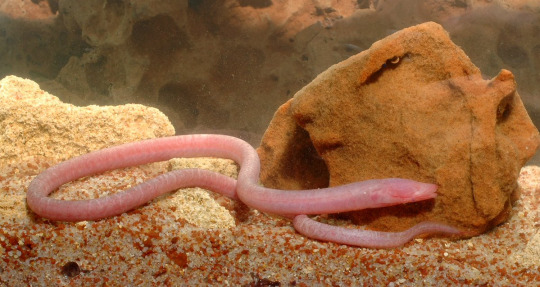
(Image: an eel with translucent, pink skin, no eyes, and ribs visible through the skin. It looks somewhat like an earthworm. End ID)
The actual largest known cave fish is Neolissochilus pnar, which gets up to 40 cm while being more massive than the eel. They are found in a single cave system 100 meters underground in India. The primary food source in the cave appears to be debris from the nearby forest that is washed into the cave during seasonal flooding. The fish may have been known to locals well before it was scientifically described, as there are stories of white cave fish going back over a century in the region.
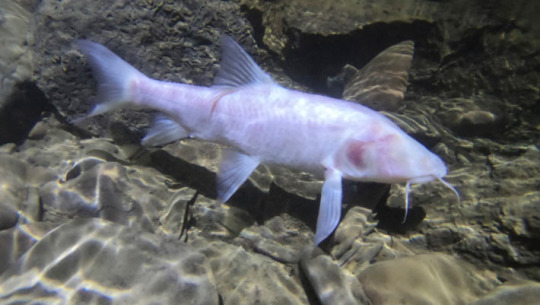
(Image: a small fish with no eyes, white skin, and a long snout with barbels on it)
The Alabama cave fish (Speoplatyrhinus poulsoni) may be the rarest species of freshwater fish in the world. They live exclusively in key cave, Alabama, USA and no more than 10 have ever been seen at a time. The population is estimated to be under 100, below the generally accepted minimum viable population for a species of 200. Fittingly enough, this means a species only found in Alabama may be severely inbred. They are believed to be triggered to mate by seasonal flooding and may be mouth brooders. Climate change-caused changes to flooding and toxins leaking into the groundwater from sewers are currently threatening them with extinction.
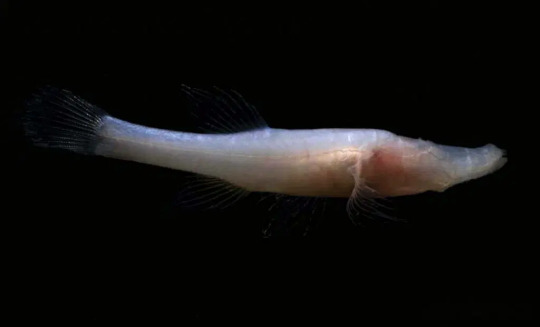
(Image: a long, white, eyeless fish with an elongated snout. Its skeleton is visible through its skin. End ID)
Typhliasina pearsei, the Mexican blind brotula or dama blanca ciega (blind white lady), lives in the cenotes of the Yucatán peninsula. Cenotes are sinkholes filled with groundwater and the ones in the Yucatán are often connected by underground caves, rivers, and aquifers. The fish are apex predators who eat shrimp and mysids and are known to coexist with other cave fish in part of their range. As with other brotulas, they are a rare example of a bony fish that gives live birth. Because of how interconnected and numerous the cenotes are, this species has one of the largest distributions of all cave fish.

(Image: an eyeless white fish with a long tail and elongated rear dorsal and anal fins. It is next to an orange rock. End ID)
Cryptotora thamicola, the cave angel fish or waterfall climbing cave fish, is the adrenaline junkie of the cave fish world. Most cave fish live in slow-moving or still water, but this daredevil lives in rapids. But just living in rapids isn't extreme enough, these guys climb waterfalls. Their large fins with hooked fin rays let them cling onto the rocks while facing into the current. They then allow food to flow right into their mouths. Unlike other walking fish, the waterfall climbers have a well-developed pelvic girdle and walk in a style very similar to tetrapods, with front and back fins alternating strides. This has made them very interesting to evolutionary biologists studying the transition from fish to tetrapods.
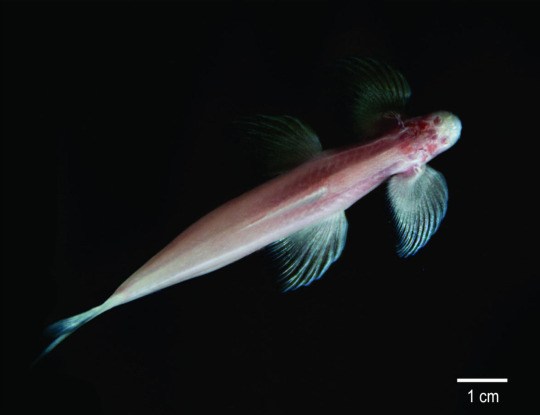
(Image: a typical cave fish with very large pectoral and pelvic fins. End ID)
The Mexican tetra (Astyanax mexicanus) is an example of a handful of fish species that have a cave form and a non-cave form. Most Mexican tetras are perfectly ordinary tetras, but one population has adapted to cave living and has developed trogomorphic traits. The cave from lack pigment, has tastebuds on its head, lacks eyes, and can store more body fat. While you would expect such radical physiological differences to mean the two populations are different species, they aren't. The two populations are fully capable of producing fertile offspring and do so in the wild. If you've ever seen a cave fish in person, there's a good chance it was one of these as the cave form has entered the pet trade and they do very well in captivity, making them the most studied cave fish.
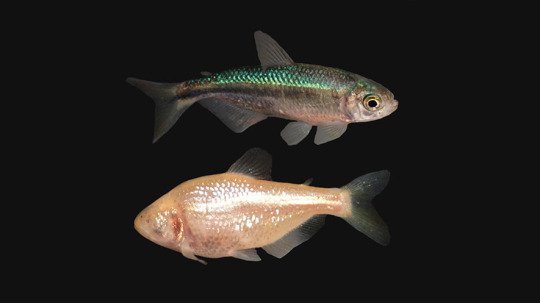
(Image: the non-cave and cave forms of the Mexican tetra seen next to each other for comparison. The non-cave form is a fairly typical silvery-green fish. The cave form is slightly more robust, white, and eyeless. End ID)
Because most cave fish are found only in a singe cave or cave system, they are fully dependent on the health of that cave. Caves tend to be very stable environments, which results in the inhabitants being pretty bad at adapting to change. Changes in water flow, introduction of new species, and pollutants can seriously harm or wipe out whole species. Many species of cave fish are rated as endangered or critically endangered based on their low populations and vulnerability to change.
#wet beast wednesday#I went into this thinking it would be quick and easy to write.#and now it's 6 hours later#cave fish#cave animals#troglofauna#cave#caves#fish#fishblr#fishposting#aquatic life#aquatic biology#biology#zoology#ecology#animal facts#evolution#informative#image described#educational#speleobiology
617 notes
·
View notes
Text
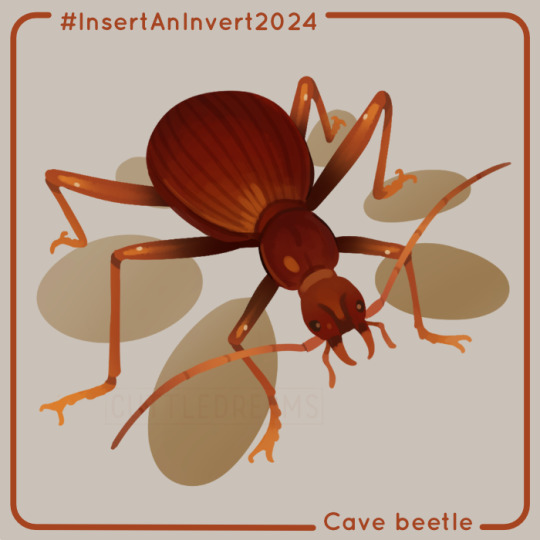
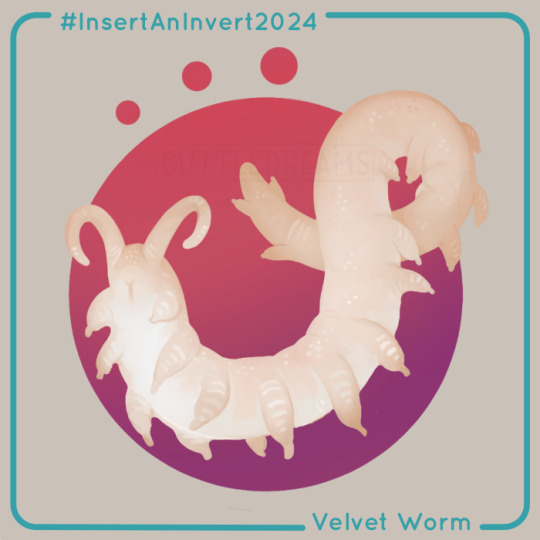


Underground gang rise up
July theme: Subterranean
Surface: Cave beetle (Sinotrechiama yunnanus)
2. Underground: Velvet worm (Peripatopsis alba)
3. Troglofauna: Cave pseudoscorpion (Titanobochica magna)
4. Stygofauna: Parabathynelid (Brevisomabathynella)
Bonus drawings in the read more!
Being sleepy as I am while working, I somehow managed to flip not just one but two of the species. I did not really grasp the mistake until some time away and coming back to post, at which I went "uhhhhh these don't match the categories" and rushed to repaint them lmao.
Bummer in that I was pretty happy with the drawings, but not-as-bummer because I can still share them o. o
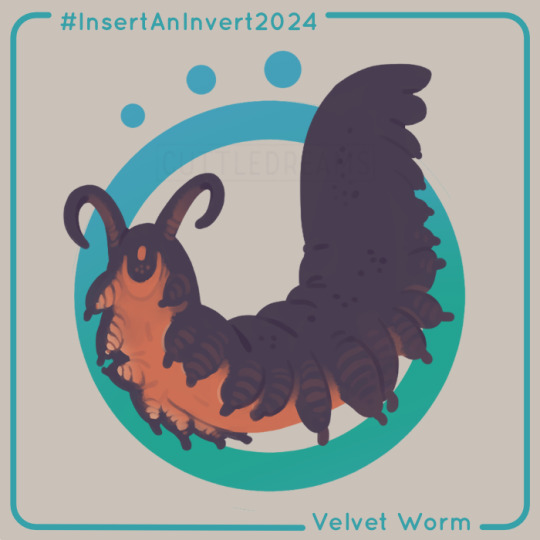
Literally not even a cave dwelling species lmao

An easy fix for this one thankfully; this beetle is actually extremely close to the correct species Sinotrechiama yunnanus, I'd just instead referenced Giraffaphaenops clarkei, having mixed up the two species while setting up my references. (tbh looking again I shoulda made this guy even lankier going by the refs but that's okay)
I love seeing these cave beetles lined up, it's genuinely really cool
#cuttledreams#insertaninvert2024#ground beetle#sinotrechiama yunnanus#velvet worm#peripatopsis alba#cave pseudoscorpion#titanobochica magna#parabathynellid#brevisomabathynella#only just now did I realize I've been mispelling pseudo on everything as psuedo#and apparently not pronounced swed-oh?? It's soo-doh???#wild#anyway gotta go fix that whoops
55 notes
·
View notes
Text
While a relatively secluded ecosystem, the caverns of Arcuterra have expanded greatly over the last few million years. Consisting of a network of tunnels, chambers and crevices spanning for miles underground, the floor space of the caves have now exceeded those of a small island comparable to Earth's Tasmania-- and has gotten large enough to have several sub-biomes within itself, some levels more superficial and closer to the outside world where the abundance of nutrients trickling in allows the lush forest-like growth of subterranean pseudo-flora, and others beneath the upper layers where groundwater and detritus accumulates, forming stagnant, muddy swamps where, against all odds, life finds a way to thrive.

One of the ecosystem's most abundant animals are the feelerflits: the caverns' only flying animals. Descended from dipteran flies, their forebearers once did lose their wings in their initial colonization--yet over time re-evolved this ability through atavistic mutations once the caves had expanded enough to make flight advantageous again: though now, in pitch black darkness and without vision.
Feelerflits, however, managed to adapt by developing especially-hypertrophied feelers both on their antennae and their abdominal cerci, giving them the ability to detect movement both forward and behind. This, coupled by pressure sensors and long hairs on their feelers, allow them to discern their environment in flight, while olfactory and theroreceptor cells allow them to pick up thermal and chemical signals to recognize food, enemies, and conspecifics.
Most of the common feelerflits (Phantasmusca spp.) are generalist omnivores, feeding on decaying matter, shroomor spores and fungi, but some, in the abundance of resources and lack of competition, have ascended a rung in the food chain. The murksquitoes (Anophelomimus spp.) have become part-time parasites, supplementing their diet of mocklichen spores by biting larger animals such as daggoths, especially females that require additional protein in producing their eggs. Others, the darkdarters (Quadropteroides spp.) have become predators, preying on other feelerflits. With their halteres enlarged to resemble a second pair of wings but used as organs of balance instead, they are agile in the air, seizing other, smaller feelerflit species with spiny grasping forelimbs and using a sharp proboscis to pierce the bodies of their prey.
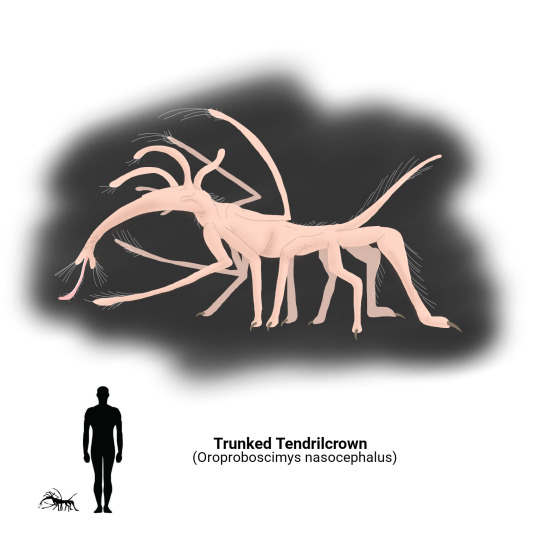
This abundance of insects, arthropods and other invertebrates has led to other unique specializations among the daggoths: the cavern systems' dominant troglofauna. Many are specialized insectivores, typically smaller species, but also some unusual outliers among the larger kinds.
One such creature is the trunked tendrilcrown (Oroproboscimys nasocephalus), a member of the cavehopper family that, unlike its other grazing kin, has adapted an elongated snout from the elongation of its lips, forming a trunk-like appendage with its mouth opening at the end, out of which emerges a long, sticky tongue equipped with small barbs, ideal for piercing through mocklichens to get at the interior, reaching into crevices to pull out rootlike mycelia, and most importantly to raid insect nests and feed on the inhabitants. Its trunklike appendage only contains its mouth, with its nostrils set far back behind the top of its head, keeping the vulnerable orfices far from reach of its biting insect prey.
Tendrilcrowns, like most other cavehoppers, are gregarious creatures that seek safety in numbers from predators like blindmutts and tendriltooths. They use their tail, atypically long for a daggoth, as a scent-marking organ to set territorial boundaries and identify related individuals. Yet, as their social behavior are merely for protection, their individual bonds are rather weak. When startled by predators, they individually flee with powerful thrusts of their leaping hind limbs, displaying little concern for their fellows whose company they only partake in to reduce the chances of individually being caught.
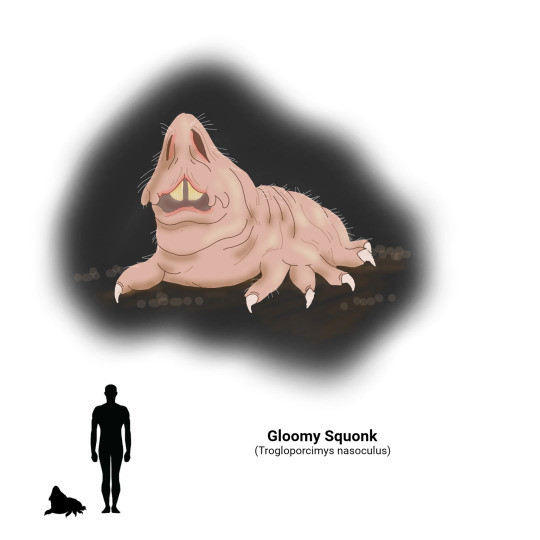
The cavehoppers may be agile and flighty creatures, but in the limited space, not all daggoths share their energetic means of movement. Some daggoths are content with a slower-paced life: especially those that live in the lower levels of the cave systems where fewer food is available and energy is better off conserved.
The gloomy squonk (Trogloporcimys nasoculus), one species of the gloomhogs in relation to the biblarodons, lives in the basement-levels of the cavern systems: where the muddy deposits gather into the large, wide chambers into a sort of underground marshland. Here, underneath the organic sludge, specialized filamentuous fungi grow in soggy, fibrous clusters, absorbing and converting the detritus back into biomass that, in turn, is the primary food of the gloomy squonk. Its ghostly eye-like orfices are in fact enlarged nostrils on its inverted, upturned snout, as it has adapted for spending much of its time wallowing in the subterranean swamps scraping off the fungi from the bottom, surfacing time and time to breathe. With larger nostrils as well as a markedly larger lung capacity, it is able to take in more air per breath, allowing it to make the most of the thin, oxygen-poor atmosphere so deep beneath the ground.
Its sluggish demeanor, large fat-storing body and glycogen-storing liver allow the gloomy squonk to survive for long periods without food, in one of the less-hospitable regions of the cavern system, where growths of its preferred forage follow irregular boom-and-bust cycles depending on how much nutrition is available from higher rungs. This, however, makes it an ideal potential meal for younger tendriltooths that may wander down lower crevices to avoid competition from aggressive and cannibalistic adults. However, while slow and typically placid, the squonk is not entirely defenseless. Its jaws, strong enough to tear fungal mycelia from rocky anchors, can also inflict a vice grip onto a would-be predator, after which it submerges into the muddy sludge in an attempt to drown its assailant.

Similarly, while some of the blindmutts became active, pouncing ambush predators, others, the cavegleaners, took on a more slow-paced lifestyle, wandering along as foragers and scavengers, picking on shroomors, insects, small daggoths and carrion, and thus alleviating competitive pressure from the tendriltooths, who now seldom consider them a threat and rarely bother attacking them.
The ridge-headed whiskersaw (Heliconasodon rubrilophus) is one such cavegleaner, often drawn to the leftover kills of tendriltooths to finish off the remains left behind once the predator is sated. Like the tendriltooth, the whiskersaw is equipped with sharp keratinous serrations on its nasal tendrils that function much like teeth. Yet now, with its foraging lifestyle, the whiskersaw now puts its false dentition to a strange use: coiling its two most prominent tendrils into tight spirals with the spines pointing outward, it then rotates them against one another as they uncoil back and forth: forming two abrading "polishers" that cleanly scrape the last residues of meat attached to bones, especially those out of reach of other predators. When uncoiled, these spiny appendages can also be inserted into hollows of bones to access the marrow, or be probed into the burrows of small prey to be extracted from their hiding spots.
The other conspicuous feature of the whiskersaw is of course the two fleshy ridges that adorn its head: the frontmost rims of which are made of highly-vascularized tissue that can be engorged and distended with specialized blood vessels to release a small amount of body heat. These are picked up by the thermoreceptors found on the nasal tendrils of other whiskersaws, in essence being used as a display organ by a species without eyes to see visual cues. Being mesothermic, like most daggoths, the display is a very energy-intensive effort in relative terms, and to the solitary creatures only means one of two things: a dominant male asserting his strength to a potential rival, or a receptive female advertising her readiness to breed. Also like the majority of other daggoths, the undeveloped but precocial young recieve minimal parental care, nursing for only a day or two before being deposited near abundant food sources conducive to their growth and survival.
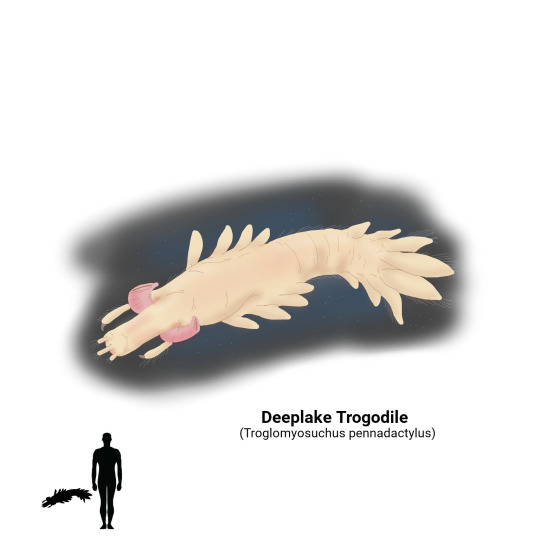
A wide variety of large fauna now thrive among the drier regions of the caverns, which, while still smaller than surface animals due to the more limited space and resources, nonetheless reach impressive sizes for a cave-dweller. But the aquatic biomes of the caverns are not left out by such trends, as some aquatic daggoths have grown quite large, in particular the deeplake trogadile (Troglomyosuchus pennadactylus) which can reach lengths of up to a meter long or more.
While the tendriltooths are the top predators of the land, the trogadiles are the apex carnivores of the underground rivers and lakes where an impressive array of organisms thrive: aquatic insects, shrish, pescopods, hampreys and tubesnouts alike, dependent on a base producer of chemosynthetic bacterial mats and aquatic meatmoss, growing in thorny fronds like animal kelp. All of these are food for the trogadile: not a picky eater, it catches food with its muscular fused nasal lobes as well as two smaller tendrils equipped with sharp claw-like points, and using its extensible snorkel-like nostrils to breathe at the surface every few minutes, sometimes lying motionless just below the surface with only its snorkels exposed, waiting to strike at unwary prey.
Their specialized limbs, modified into flipper-like paddles, undulate rhythmically to propel themselves through the water, but, conversely, now make them practically immobile on land as grown adults, entirely helpless and vulnerable if beached. Young individuals, a few inches long at birth, however can manage a clumsy scuttle across dry land, enough to be able to disperse into other bodies of water. Once grown, they are permanently waterbound, though populations can still intermingle genetically despite isolated pools being separated, due to the amphibious capabilities of the juveniles.
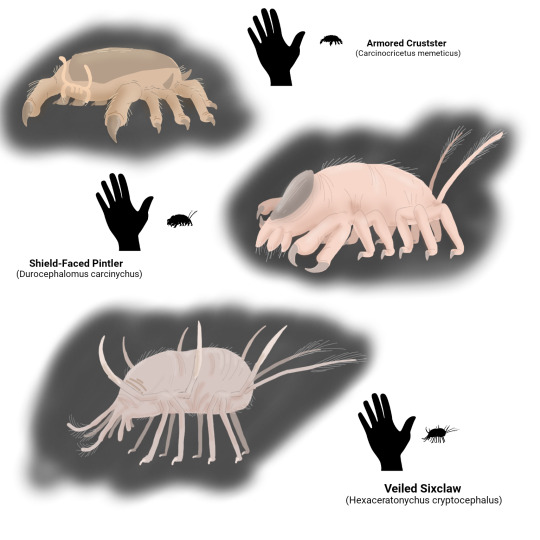
Many branches of the daggoth evolutionary family have thus produced a wide variety of some of the strangest and most alien-looking forms ever assumed by a rodent: to such an extent that many are scarcely ever recognizable as such. Many of these arise from derived lineages, but, from the gothtles, one of the most basal lineages, bizarre yet oddly familiar forms too have since emerged. These animals, in their basal forms once top predator of the caves, now find themselves at the bottom of the food chain, preyed upon by their distant kin: while some such as the xenomures adapted to flee and hide, others armed themselves with strange weaponry to to ward off and injure their enemies.
The veiled sixclaw (Hexaceratonychus cryptocephalus) is one such unusual species that, when threatened, conceals its face and sensitive nasal tendrils in a fold of thick skin as it curls itself up into a tight ball: leaving only six prominent defensive spines exposed. These long, horn-like projections are, surprisingly, actually elongated claws: attached to mobile, specialized digits, they can point in any direction to painfully stick into a predator's mouth, and, even when moving about and actively foraging, the sixclaw bears its weaponry in arms, raised above and behind its body to make it difficult to grab. Able to move together, they can pinch the tendrils and toes of an enemy, hard enough to draw blood, even if successfully picked up.
This ability for the digits to grip in junction has been put to good use by some species. The shield-faced pintler (Durocephalomus carcinychus) specifically has hypertrophied the first two pairs of its digits to use almost as grasping pincers, able to partly oppose and each equipped with a large, retractable claw. These serve it good use in excavating burrows, tearing apart food, defending itself and, most remarkably, used in intraspecific combat. Males can be up to twice as big as a female, and sport greatly enlarged claws and a larger keratinous facial shield that, while used in the females merely to protect their faces while burrowing, are defenses for males when they fight over territory, mates and resources, lifting each other up and tossing each other away as they tussle for dominance, with the losing combatant occasionally losing a few digits in the process.
These defenses, armor and burrowing abilities all reach their peak in the armored crustster (Carcinocricetus memeticus), a smaller and more placid relative of the pintlers that has evolved a more compact body and a single enlarged shield covering most of its back that, with its sharp-spined edges and smooth curved shape, makes it resistant to all but the most specialized of predators. Its powerful front claws are primarily used for digging, while its back, reinforced by a thick and sturdy spine with multiple interlocking vertebral processes, allow it great strength for its size, able to use it for leverage to wedge itself under large stones or into crevices, both to make itself inaccessible to enemies trying to fish it out of its hiding spots, as well as access small invertebrate prey taking shelter underneath.
#speculative evolution#speculative biology#spec evo#speculative zoology#hamster's paradise#biome post
130 notes
·
View notes
Text
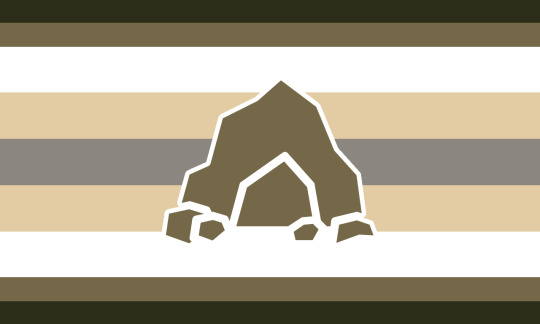

trogloconic .
a species term for troglofauna ( primarily lives in caves ) draconics / dragons .
tagging @radiomogai, @rwuffles, @specieschive, @seasulfur, @luxdraconia, and @gendrakon . symbol from here .
26 notes
·
View notes
Text

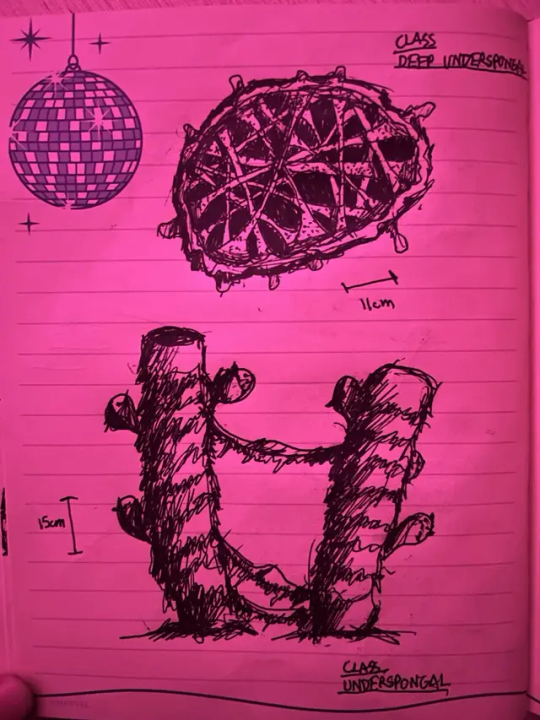
Next up on our alien animals, the Sponges !!!!
Of which there are MANY MANY MANY on Jom'Gol... the entire planet was once covered by sponges for nearly 1 billion years in its early history....
(AN1 C2) Clade: Spongae
A clade of asymmetricans that have internal, flexible skeletons made of spongin fibers.
PHYLUM DEEPSPONGAE
Phylum of sponge existing in the lower stratification of the marine biosphere, containing a pseudo-hemocoel and porous membrane.
(AN1 C2-a) Clade: Fossospongae
A clade of sponge that rely on ambient environment temperature and have small mesohyl nodes within sponge structures.
(AN1 C2-ai) Clade: Saltuspongae
A clade of fossospongae that thrive in salt-rich and copper-rich environments within the lower stratification of the marine biosphere.
Class Seafloor Spongeforest
Class of colonial sponge that organize into massive forest-like hives on the seafloor with other members of the same class.
(AN1 C2-b) Clade: Hadeospongae
A clade of sponge that have large mesoglea organ tissues to regulate pressure and contain biological antifreeze agents to regulate core temperature.
Class Abyssal Sponges
Class of sponge that exist in ocean trenches and deep marine fissures in the abyssal and hadal zones of the ocean.
Class Deep Underspongal
Class of sponge that are strictly stygofauna and live in brackish subterranean waters within aquifers, deep flooded caves, and some vugs.
(AN1 C2-c) Clade: Fractospongae
A clade of sponge that relies on a branching hemocoel to deliver nutrients to areas of the sponge not able to reach food.
(AN1 C2-ci) Clade: Underspongae
A clade of fractospongae that use entirely chemical synthesis for ectothermy and navigation rather than light.
Class Underspongal
Class of sponge that are troglofauna and frequently line low-pressure cave systems and non-brackish pools of cave water.
#art#artists on tumblr#worldbuilding#jomgol#spec bio#spec evo#speculative biology#speculative evolution#traditional art#traditional sketch#alien#alien species#xenobiology#speculative zoology#creature design#creature
47 notes
·
View notes
Text
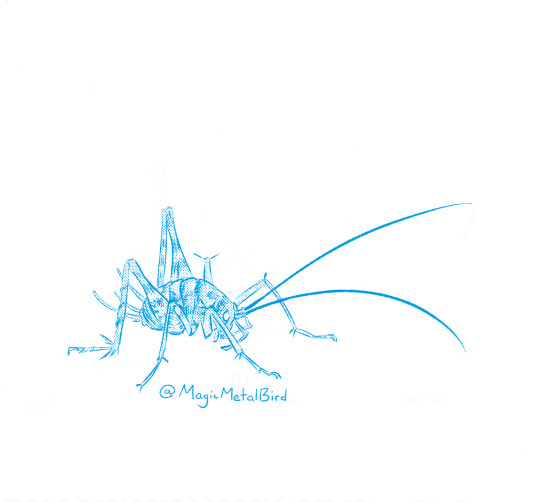
InsertAnInvert 2024 Subterranean week 3: troglofauna
spricket (sraculoides)
#art#comics#artists on tumblr#screentone#halftone#invertebrates#inverts#sciart#noAI#human artist#queer artist#nonbinary artist#cute#animals#SciArt#insertaninvert2024#insertaninvert#nature#funny little guys#spricket#insect#bug
12 notes
·
View notes
Text
hello bug enjoyers. lookit this video
youtube
things I really liked:
dry sense of humor
correct opinions about the definition of "bug"
I get to wax nostalgic about walking with dinosaurs: chased by sea monsters
remarkably well-sourced
cool medieval music that makes me want to prance around while holding a sanctacaris like the lion king
really chill vibes overall
anyway bye I'm off to watch the one about troglofauna
4 notes
·
View notes
Text
Troglofauna fandom is about to go crazy!

Wait, beneath the sea floor?


OUGHGH??
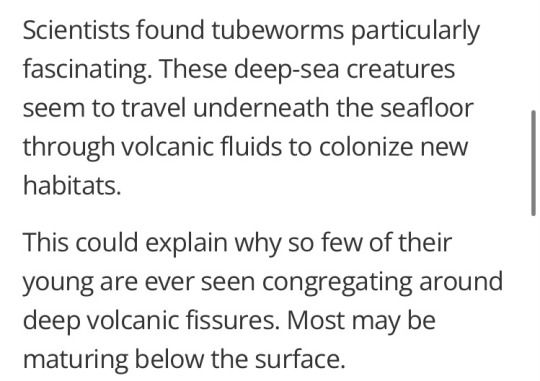
OIUOHGHHVOIH!!!!!
125K notes
·
View notes
Text
my mind is fucking deep in Veryovkina squeezing my brain into the dead man's sump at the bottom bc I want to become part of the biological sludge of pale flabby goo if my teleportation spell doesn't work I will simply try Movile Cave so I can make friends with the myriad of myriapoda the children may yearn for the mines BUT I A GROWN ADULT WOMAN HAVE DEVELOPED MY TASTES.
gonna go down into the cave and start slurping up the chelicerae to truly incorperate myself as apex predator. it's a skill issue that children only want the mines- DO THEY NOT SEE THE CHEMOSYNTHETIC POTENTIAL??????????
THEY SAY DIAMONDS ARE A GIRL'S BEST FRIEND WELL WHAT ABOUT TROGLOFAUNA THEY NEED LOVE TOO AND I WILL SACRIFICE MY VIRGIN TO IT (I keep her in a different, shittier cave. she's well fed and has a bunch of bones. all 540 she needs to assemble herself.
#tumblr#idk#thoughts#my brain#I want to go deep#( ͡° ͜ʖ ͡°)#real women yearn for THE ABYSS#fuck your diamonds#yelling into the void
1 note
·
View note
Text
random but still very relevant mortally coiled lore
so pre-destruction era, a sort of underground city is constructed beneath/within a mountain. it's mostly for mining, but not exclusively- it's a self-sustaining community, with craftsmen, farmers, healers, etc. at some point there's a really major seismic event that causes the city entrance to completely collapse. the city is VERY deep underground, and it's believed that all known entrances are now entirely sealed off. The city and all of its inhabitants are considered lost for good.
Turns out that it really WAS just the entrances that collapsed- the city itself was designed to last, while the actual entrances (at least the sections closer to the surface) were all renovated mineshafts with less structural stability. so for generations on generation on generations the people who were in the underground city when the tunnels collapsed just sort of. figured out how to survive entirely underground. since they were ALREADY a pretty self-reliant civilization, theyre capable of not completely dying off without outside help. for food, there's some already-established subterran farms growing fungi, edible mosses, and even rhubarb-esque plants capable of growing without much (if any) light, along with access to underground rivers with cave-fish.
So, eventually, the people in this underground city excavate one of the collapsed tunnels and return to the surface. At this point, the residents have diverged WILDLY from the normal population- a significant portion are born with poor eyesight, with many being completely blind or even eyeless. you got mammids resembling moles/bats/mole-rats/etc, semi-transparent aquuids, reptids resembling olms, cave-beetle insectids, and the population overall ending up resembling typical troglofauna/stygofauna.
those on the surface and those from this underground civilization (commonly called the Lost Cities by the surfacers) start interaction again. theyre still pretty seperate, considering it is now physically challenging for a surfacer to live in the Lost Cities/a deepfolk to live on the surface, but there's at least interaction and between the two now.
this brings us to the modern era. It's now fairly common for surfacers to move into the Lost Cities, or for deepfolk to move out of the Cities, but it can be really difficult for either to adjust to swapping. Hence, the phenomenon of "Surface-scouting" by deepfolk; young native deepfolk who have spent their entire lives underground will sometimes accompany a non-native living in the Lost Cities to the surface, typically when the surfacer is visiting relatives or friends, in order to "properly" experience the surface. It's considered a very trendy thing to do, so seeing a deepfolk experiencing the surface world for the first time accompanied by a friendly surfacer is, while not an everyday occurrence, not unheard of.
why, exactly, is all this relevant?
it's relevant because Fane uses it as a cover for Null. It is VITAL for their little posse to lay as low as possible, and normally a fucked up lizard guy without eyes would stick out like a sore thumb. but no actually this is Normal and Fine see null is just a deepfolk from the Lost City and Fane is their surface-guide! and like sure Null is very much NOT a deepfolk and looks fucking weird even in that context but Fane is the living embodiment of telling lies so that's not even a problem. That paired with Bang ensuring that they're not traveling in any sort of predictable path makes the Nil gang almost completely hopeless in tracking them down unless they want to follow up on Literally Every Instance of surface tourism.
#howling#mortally coiled#this is typically something id post on my mortally coiled sideblog but like. whatever#partially i wanted to just show a small snippet of how much effort and thought ive put into this universe#ill like think of a situation that's actually part of the main plot and then be like#ok now i need to come up with the historical events that would make this situation possible#hence the creation of mole tourists
0 notes
Note
oh i love this meme, specifically, um: witches' brew
https://8tracks.com/thatgirlinthecorner/witches-brew
went ahead and made it a whole mix! tracks under cut
haunted beach party - the pandoras/demon’s fire - the raveonettes/dark issues - mourn/bitter fruit - the kills/tainted in sin - le butcherettes/helen in the woods - TORRES/toil + trouble - KASMS/scratch your name - the noisettes/i’d rather be burned as a witch - eartha kitt
8 notes
·
View notes
Text
im a troglofauna in my own right really, the cave i never leave is my house
sometimes when im outside i look at my skin and.think "wow i have the skin tone of a cave creature thats adapted to live without eyes"
7 notes
·
View notes
Text




Next up is Superphylum Archeocarnae (Archaic Meat)
Named aptly for both its appearance, composition, AND age, and typically only troglofauna (cave-dwelling) or some amount of subterranean. Another very very old clade of organisms, splitting off from the rest of Animals only about 20 million years after the first semi-complex multicellular animals started to exist on the planet.
(AN2 B) Clade: Archeocarnae
A clade of animals that contain all ancestors and relatives of Archaic Meat.
Superphylum Archaic Meat
A taxa of animals possessing asymmetrical symmetry and a tissue structure primarily made of mysium and lipids.
(AN2 B1) Clade: Underwraithidae
A clade of archaic meat that produces egg sacs for the production of offspring.
PHYLUM UNDERWRAITH
A taxa of archaic meat that produces egg sacs for the production of offspring.
(AN2 B1-a) Clade: Mobicarnis
A clade of underwraith that uses a proto-nerve net for chemical and photoreactive ambulatory locomotion.
Class Mobile Carnis
Class of ambulatory mobicarnis that is mostly predatory and consumes troglofauna.
(AN2 B1-b) Clade: Carnitoridae
A clade of underwraith that uses non-conscious chemical and ciliary locomotion.
Class Podhive Carnis
Class of carnitoridae that have oral “crowns”, may be singular or colonial, and feed on both autotrophic and heterotrophic troglofauna and stygofauna.
Class Membranous Carnis
Class of carnitoridae that have a thin gel matrix, typically adhere to cave walls, and consume autotrophic organisms, typically absorbing microcosma and other chemotrophic organisms.
(AN2 B2) Clade: Monospermocarnidae
A clade of archaic meat that produces seed-like gametes for production of offspring.
PHYLUM PSEUDOPHYLA
Phylum of monospermocarnids that produce fruit-like nodules for gamete dispersal, and possess fat reservoirs for nutrient storage.
(AN2 B2-a) Clade: Pseudocorodalia
A clade of pseudophyla that produces a layer of calcium salt for dermal protection and moisture regulation, and consume nutrients from mineralized groundwater.
Class Blood Pseudocoral
Only extant class of pseudocorodalia, consuming chemotrophic organisms from cave strata and other planktonic organisms from both flowing and stagnant subterranean water.
(AN2 B2-b) Clade: Vagrange Carnophyae
A clade of pseudophyla that possesses basic chemical navigation to grow towards floral and faunal food sources.
Class Coarse Flowering
Class of vagrange carnophyae that consume slow or sessile organisms with crowned tentacles or toothed flat pads, often directly predatory to fauna; not fully troglofauna and are partially terrestrial.
Class Bulbing Carnis
Class of vagrange carnophyae that capture and consume a variety of heterotrophic organisms using deceptive or aggressive mimicry in appearance, scents, pheromone signals, or offering some form of nutrient in exchange for gamete nodule dispersal; not fully troglofauna and are partially terrestrial.
PHYLUM GANGLA
Phylum of monospermocarnids that spread diaspores via air or water currents and possess no fat reservoirs or nutrient storage.
(AN2 B2-c) Clade: Dermogangla
A clade of gangla that use an internal proto-hemocoel around a lipid bilayer to communicate, regulate nutrient flow, and navigate to food sources.
Class Thickflesh Gangla
Class of gangla that consume a variety of chemotrophic and heterotrophic organisms on the floor of cavernous, deep subterranean, or dark and moist terrestrial environments that often form the basis of organism-rich reef-knoll-like environments.
(AN2 B2-d) Clade: Gangla Vascula
A clade of gangla that use a single lipid filament to navigate to food sources and use an outer hair-filament network to communicate.
Class Vessel Cave Gangla
Class of gangla that stretch across various mediums to act as a web to capture prey, including spores, small fauna, and planktonic organisms; organizing into small colonial clusters within a geometric web.
Class Tubelike Cave Gangla
Class of gangla that use capillary action to transport nutrients across large subterranean and below-soil hives; many members of this class gain nutrients from symbiotic relationships with other organisms that are cave-dwelling or exist in subsurface environments.
#art#artists on tumblr#worldbuilding#jomgol#spec evo#spec bio#speculative biology#speculative evolution#traditional art#traditional drawing#traditional sketch#xenobiology#creature design#creature#alien species#alien#speculative zoology#speculative worldbuilding
15 notes
·
View notes
Text
troglofauna replied to your video “it’s a weird choice of comfort album, i know, but it works for me”
full same tho
<3
3 notes
·
View notes